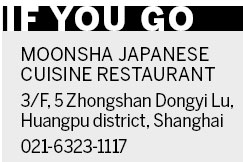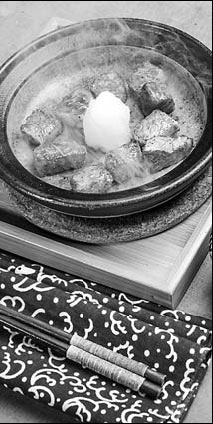Teppanyaki means preparation is fun, too
Updated: 2012-04-08 07:50
By Yang Yijun in Shanghai(China Daily)
|
|||||||
|
MoonSha's beef steak cooked in a pottery pot is featured on the restaurant's spring menu. Provided to China Daily |
Waiting for the food to be served on the table is probably the most tortured period of time you spend sitting in a restaurant. But in MoonSha Japanese restaurant on the Bund, the waiting time is also a part of the elegant dining experience.
The restaurant is divided into two areas: the teppanyaki area in private rooms and the Japanese cuisine area.
The beauty of teppanyaki lies in that there is no rehearsal for the cooking. The chef has to present the whole process in front of the guests and no mistake is allowed. Watching the chef's adept skills and the sizzling food is an enjoyable bonus to the meal.
After we finished the day's soup and baked French bread, our chef Akira Chen came into the private room. Nicknamed Dabao, Chen, the deputy executive teppanyaki chef from Taiwan, is known for his delicate skills and friendly service.
While cooking, he explained the major steps and ingredients to us, and even let us try to make the fried rice. Though it takes just a few moves, it was quite an interesting experience.
The temperature in the center of the teppanyaki plate was kept at 400 C, which helped the seafood and the meat to lock in the juice. It turned out that the texture of the seafood was quite impressive - the king prawn was chewy, and the salmon was crispy outside and tender inside. All the food was beautifully presented with a French touch.
After the seafood, a salad was served to prepare our palate for the meat courses. Chen made a unique salad for us with only an organic egg and some organic vegetables.
He separated the yolk from the egg and fried the egg white to a soft white pancake. Then he carefully put the yolk on the teppanyaki plate and grilled it slowly. This part was the most difficult because it was hard to keep the yolk complete.
The egg white pancake, the soft-centered yolk and the vegetable were all served with the Japanese style ponzu sesame sauce and parsley. I not only tasted a refreshing spring salad, but also felt the heart of the chef.
After that came the meat. We had the Australian prime fillet and pork tenderloin. The pork was served with pineapple, mushroom and crispy garlic chips, which were fresh and sweet after being soaked in milk.
Meat was served with four-color pepper - yellow, green, red and black - representing the four stages of the peppers' growth.
The salt was also special. The chef used Bolivian Andes Mountain salt, which contains rich iron and calcium. The salt has pink color and mild flavor that brings out the original flavor of the food.
To finish the meal with a homemade dessert, we moved to the restaurant's Japanese cuisine area, which has a splendid view of the Huangpu River and Pudong skyline.

The lemon ice cream parfait, Japanese cake and red-bean soup were all suitable for the season because of their relatively light tastes.
For Japanese cuisine, the restaurant has been recently highlighting Hokkaido seafood, such as premier lobster, baby abalones, oysters, rays' fin and many other treasures from across the ocean.
A substantial meal at the MoonSha is about 500 yuan ($80) for teppanyaki and 350 yuan ($55) for Japanese cuisine per person.
yangyijun@chinadaily.com.cn
(China Daily 04/08/2012 page13)
